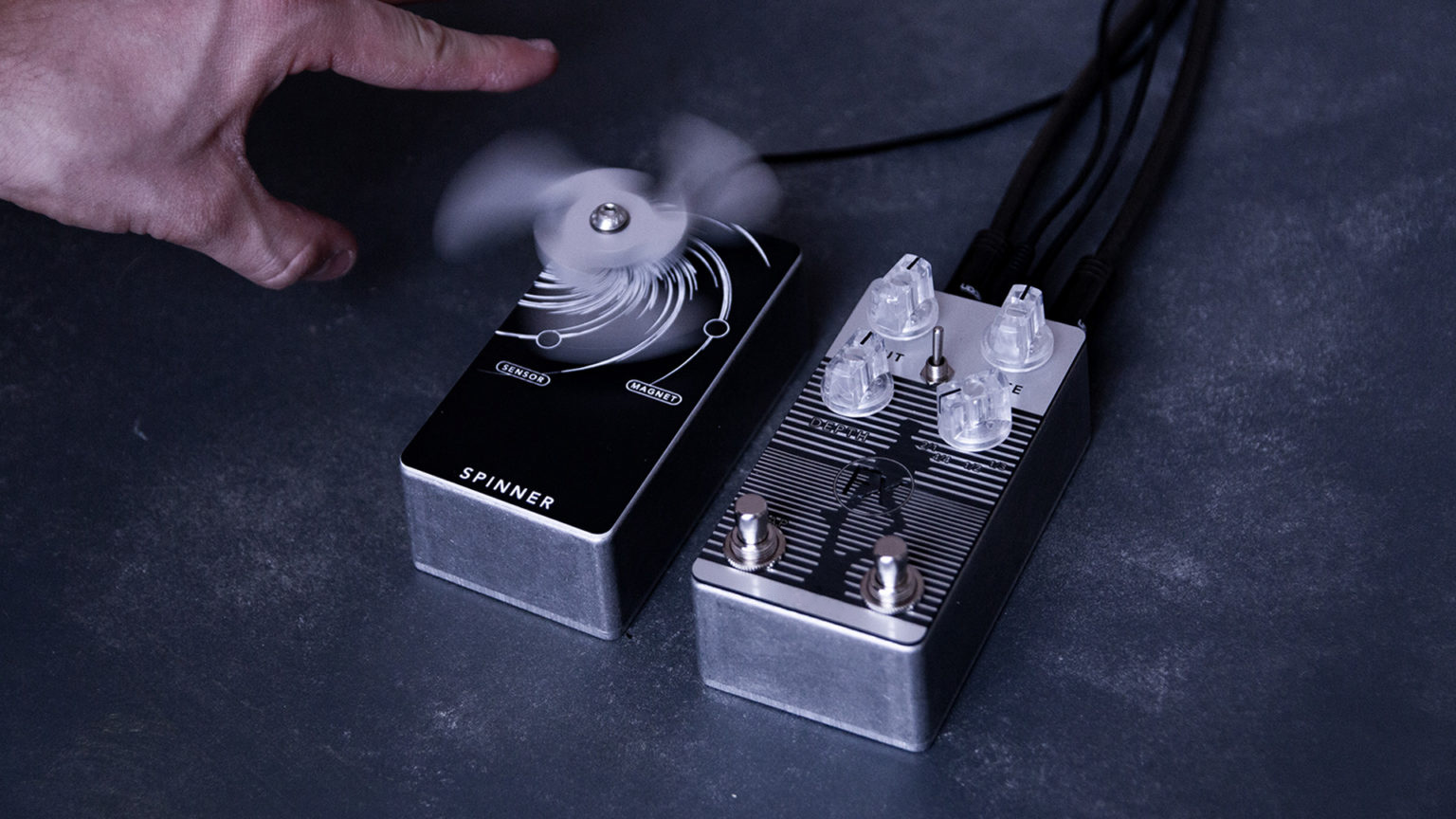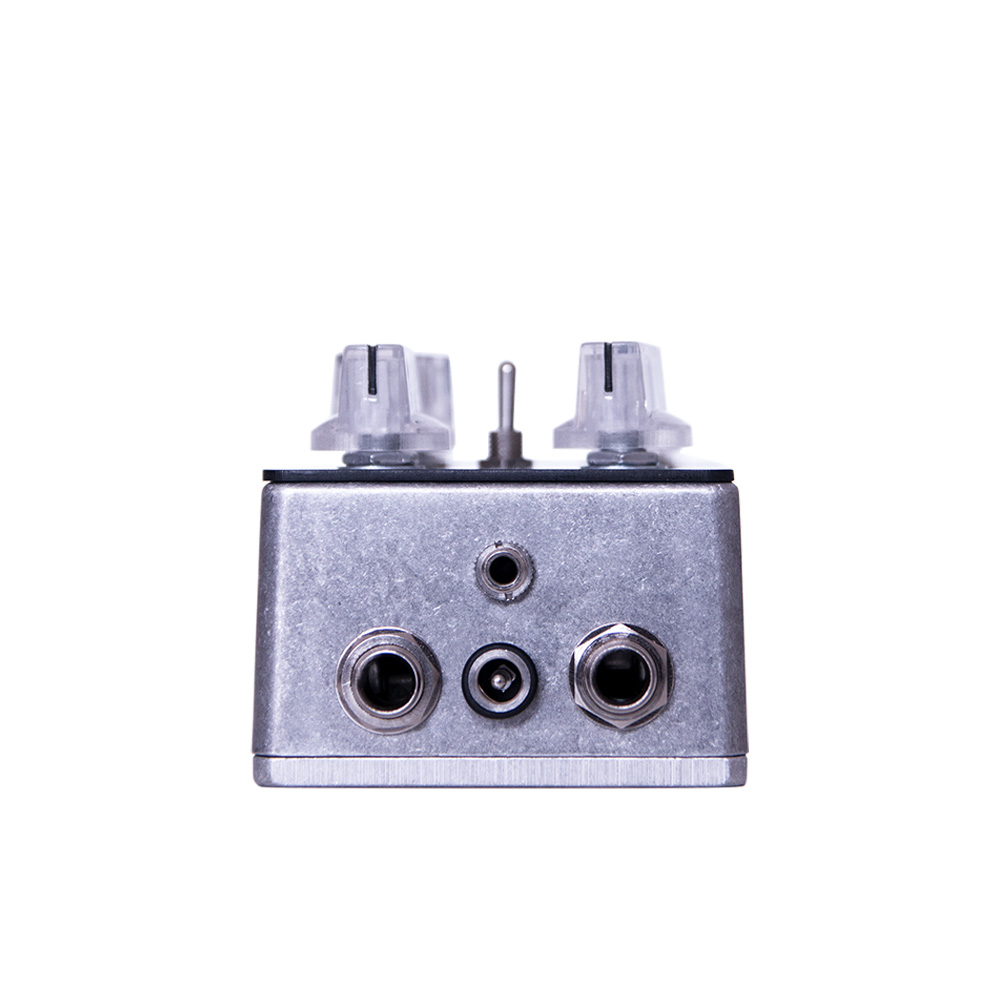
sound in motion
From the lonely desert plains of spaghetti western
to the stuttering chopped-up notes of the most epileptic EDM,
tremolo is everywhere.
That very simple effect can find its place in any context,
no matter which style you’re playing or what the rest of your rig is.
opening up the scope of possibilities
For the first time we’re using a microcontroller in one of our pedals.
However, we’re not making any compromise sound-wise, your signal path remains 100% analog.
That new element gives us infinite possibilities when it comes to sound and settings.
For example, that new pedal’s footswitches have several functions.
Therefore, you may interact with them via short or long pushes.
We also have pushed the trimpots concept to its maximum with hidden settings.
You may access additional settings by keeping the bypass footswitch pressed, such as hidden LFOs.
This is what we call the Trimpot mode.

potentiometers
OUT, the output level.
Up to +6dB without additional saturation.
DEPTH, the intensity of the tremolo.
At minimum settings, there’s almost no tremolo to be heard.
At maximum settings, the tremolo cuts off the sound completely.
RATE, to set up the speed of the tremolo, from a slow wave to a ring modulator.
switches
SUBDIVISION, the rotary knob on the bottom right-hand corner featuring four positions.
It divides up the original tempo which allows you to get faster speeds from your tremolo.
Tap the tempo and divide it any way you like!
Divisions are 8/4 (twice as slow), 4/4 (quarter note), ½ (eighth note) and ⅓ (triplet).
This will help you get heard through a crowed mix and create your own tempo without any hassle.
LFO, a 3-position switch to choose the waveform.
Up a sinus, in the middle position a triangle and down a square.
Others are available via the trimpot mode.
tap switch
TAP There’s no RATE knob, everything is done with the Tap Tempo.
You just need to tap on the footswitch twice for the system to calculate the tempo and apply it to the current effect.
However, three to five taps will be more precise, and the pedal will calculate an average before applying it.
FEEDBACK, the tremolo goes into self-oscillation after holding the Tap Tempo footswitch for more than 500 ms when the pedal is turned on.
The oscillation comes in gradually and then stops in a very elegant way once you release the switch.
KILL SWITCH, when the effect is disabled, a single press on this switch mutes the sound.
A real kill switch in a tremolo pedal.
KILL SWITCH MODE, if you keep the +5sec switch pressed when the effect is off you can activate the Kill Switch mode.
We preferred to leave the possibility of turning it on or off for those who set the Tap Tempo when the effect is bypassed.
on/off switch
ON/OFF, turns the pedal on and off with a single push.
When the pedal is switched off, the red LED blinks lightly.
When it is on, the white LED blinks intensely.
It blinks in time with the tremolo’s RATE.
TRIMPOT MODE, to access new hidden settings, hold the switch for more than two seconds.
The LED turns blue.
The knobs control other settings that will be detailed later.
To exit Trimpot mode, don’t touch any knob or switch for more than ten seconds, or tap the switch again.
A short push is enough to exit this mode.

trimpots
BIAS, to saturate your modulating signal, the LFO. Originally setup at 3/10.
GAIN, to push the guitar’s signal until it distorts. Originally setup at 7/10.
sliding switchs
TAP, leave it in the up position to use the Spinner by connecting it to the mini jack.
By putting the switch down, you can connect a tap tempo controller instead of the Spinner.
When changing the position of that switch, unplug the power supply of the pedal then plug it back in.

potentiometers
OUT remains the same since it’s analog.
DEPTH becomes FREE_SUBDIVISION, for those with an extremely precise rhythmic ear.
Use the know to get your own time division!
RATE becomes SYMMETRY, a setting that allows you to transform the LFO shape.
When using the triangle shape set up towards 0 you can create an upward ramp,
set up at noon you get an asymmetrical triangle and set up at maximum gets you a downward ramp.
When using the square shape, you can play around with the cyclical side of the square signal.
It is originally set up at 50% (knob at noon), so you can set it up higher or lower.
When using the sinus shape, you get a classic sinus at the 50% setting.
The minimum setting gets you -|sin(x)| and the maximum, |sin(x)|.
switches
The LFO switch gets you 3 additional shapes, as follows:
A random shape, a sin(x)+sin(2x) and finally sin(x)+sin(3x)+sin(5x).
The subdivision rotary switch gets you new divisions:
7/8, 3/4, 5/8 et enfin 1/4.
Maths are fun right?

microcontroler
The chip can easily be removed and changed at any time.
This allows you to update the firmware, but mostly…
We will be offering new chips featuring new waveforms!
stereo mini jack
Just like the Element, the Trémolo has an additional mini jack plug at the back.
It can be used to plug the Spinner in.
It will automatically communicate with the Trémolo.
You may also plug an external tap tempo like our Tap.
In order to do that, you need to switch the Tap trimpot down.
Once you’ve done that, the external and the built-in Tap Tempo switches can communicate and simultaneously control the pedal.

the spinner’s modes
At the back of the pedal, far from our favorite rock stars’ killer kick,
is a 3-way switch that allows you to choose how the Spinner operates.
ACCELERATEUR, the faster the Spinner spins, the more the tremolo accelerates.
This happens when the switch is in the upper position.
When the pedal has been turned off, the effect will be turned on by the Spinner and turned back off at the end of the rotation.
KILL SWITCH, kick the Spinner and the signal cuts every time a magnet comes in front of the Sensor.
This happens when the switch is in the middle position.
RALENTISSEUR, the faster the Spinner spins, the slower the tremolo goes.
This happens when the switch is the lower position.
Like the accelerating position, the rotation turns the effect on even when the pedal is switched off.
magnets
Since the Spinner is the source of expression,
you may stop it with your foot to turn the tremolo off or make it go back to its original speed.
You may also add a magnet on the Magnet spot to make the Spinner slow down earlier.
It makes the rotation shorter, and you don’t have to stop it with your foot anymore.
trimpots
TH_H, the threshold that activates the tremolo when it has been turned off.
TH-L, the threshold that deactivates the tremolo.
IMPACT, to control the acceleration and deceleration of the tremolo rate.







